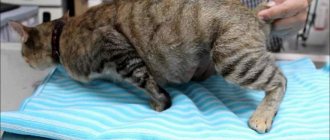The procedure that deprives a cat of the ability to reproduce is called sterilization, and in the vast majority of cases it is resorted to by owners who do not want to raise kittens. Sterilization of a pregnant cat is a separate topic that requires close attention.
Veterinarians recommend allowing a pregnant cat to bear and give birth to kittens, and only after that performing an operation to eliminate reproductive function. In some cases, when there is a risk of developing dangerous complications that could lead to death for the pet, an emergency operation is performed to remove the uterus with the fetuses in it.
Is it possible to sterilize a cat during pregnancy?
The answer to the question given in the subtitle is: it is possible, but it is very advisable to let her finish her pregnancy calmly, and first make sure that all the kittens are settled.
Only in this case will nothing threaten the cat’s health.
Unfortunately, such an ideal solution to this issue is unlikely.
The following is a list of reasons why a cat may be spayed during pregnancy:
- If the cat is too old, i.e. she is too old to bear kittens. For example, more than 10.
- The cat has health problems caused by pregnancy.
- Some pathologies have arisen in the development of the embryo. Here - during the veterinarian's examination, it was discovered that they were dead or had some kind of deformity.
- If the animal has an infection that requires very strong medications to eliminate.
- If the cat is nursing recently born kittens, and is now again in the early stages of pregnancy.
What is the essence of sterilization?
The sterilization procedure consists of surgically removing the ovaries from a female animal, while preserving the uterus and other reproductive organs. There is a similar operation performed on cats. It's called castration. In this case, the cats' testes are removed. If a similar operation is performed on cats, the uterus is also removed.
The spaying procedure involves removing the cat's ovaries.
Removal of the uterus is practiced to prevent the cat from contracting various diseases. These can be inflammations of various natures, as well as cancer. From a physiological point of view, to interrupt the reproductive function of an animal, it is enough to remove only the ovary, and the uterus can remain intact.
After this operation, your cat will gradually stop producing estrogen over the course of a month. As a result, the hormonal levels will decrease and she will become calm. In this way, you can quickly rid the animal of unnecessary aggressiveness both towards other members of the cat family and towards people.
Removal of the uterus is practiced to prevent the cat from contracting various diseases.
However, there are factors that interfere with sterilization:
- weakened condition of the animal as a result of prolonged starvation;
- presence of diseases;
- state of pregnancy.
If in the first two cases you have to resort to replacement therapy with hormonal drugs, such as Contrasex, then in the case of pregnancy, the decision about possible sterilization will be made by a veterinarian. The fact is that, despite its relative simplicity, such an operation can have a fairly serious impact on the animal’s body. Any type of operation is especially dangerous when the cat is pregnant, because this can lead to both her death and the death of the kittens.
The optimal age for sterilizing a cat is considered to be 7-8 months.
The optimal age for sterilizing a cat is considered to be 7-8 months. It is undesirable to carry it out earlier, since the animal’s body has not yet formed at this time, and therefore there is a high risk of complications. At the same time, there is also no need to delay the operation, since the older the animal, the worse it will tolerate it.
Before surgery, animals over 10 years of age are examined. For example, they donate blood for analysis, have their heart function checked and consult with a cardiologist. This allows the animal to undergo surgery without complications.
Before surgery, animals over 10 years of age are examined
How is sterilization surgery performed on a pregnant cat?
Scientifically, the procedure is called “extirpation of the pregnant uterus.”
It is usually done only for medical reasons. Most often, nothing less than to save a life. Such an operation, i.e. Sterilizing a healthy, pregnant cat is not recommended by veterinarians.
Reason: during pregnancy, the animal’s body (like the human body) undergoes very large changes both at the hormonal and physiological levels.
Therefore, there is a very strong possibility that the cat will lose a large amount of blood during this operation and will have to recover for a long time. Longer than after conventional sterilization.
Attention!
It is advisable that the cat be vaccinated at least a month before sterilization. Then there will be no risk of getting a viral infection.
In addition, the suture after sterilization of a pregnant cat is much wider than that of one that was not pregnant during the procedure.
But if the cat owner is absolutely sure of the need for surgery, and is aware of all the risks to which he exposes his cat, then many clinics take this step.
Even a veterinarian with extensive experience will not be able to complete this task. Because it is impossible to remove embryos and at the same time not damage the walls of the uterus.
So what is the operation? The bicornuate uterus of an animal is large and can accommodate not one embryo, but several. An incision is made in the abdomen, the ovaries and uterus with embryos are simply removed.
Reference!
Where is it better to perform the operation - in a clinic or at home? Of course, at the veterinary clinic. All the conditions are there. And it is possible to provide assistance if an emergency occurs.
But, at the same time, an important advantage of sterilization at home is less stress for the cat.
Postoperative care
It is important for the owner to take care of the safety of his pet after surgery, since while under the influence of narcotic substances, the cat may not control its movements and cause harm to itself. It is recommended to transport the operated animal in a special carrier. During the period of recovery from anesthesia, the cat's pulse and breathing slow down significantly, and the body temperature also decreases. There is a risk of cat hypothermia, and if it is cold outside, it is recommended to cover the pet with a warm blanket and place a heating pad under its back.
Note! While in a narcotic sleep, cats' eyes do not close and there is a high risk of developing inflammatory processes in the cornea of the eye. In order to avoid such complications, it is necessary to close and open the cat’s eyes several times over the course of an hour.
After the cat has completely recovered from anesthesia, it is necessary to offer the cat a small amount of water, as the thirst will be very strong. You can give your cat small portions of food after a few hours. But in most cases, the animal has no appetite and this is a variant of the norm.
Why is surgery dangerous during pregnancy?
The dangers of the operation are as follows:
- The uterus of a pregnant cat is literally pierced by a huge number of blood vessels.
- Blood loss will be much greater than after conventional sterilization. Therefore, the postoperative suture will be larger.
- The cat will take longer to recover. Still would! Her body is subjected to even greater hormonal and physical stress than during conventional sterilization.
Important!
It should be remembered that sterilization of cats, absolutely any, is a sign that the owner is responsible for the care of the animal and its health.
Veterinarian advice
Cat owners decide to sterilize their cats so that their pet does not suffer from loneliness. Experts recommend carrying out such an operation after the female is at least 8 months old, then her body will already be practically formed.
Surgery can be performed at a later age, but you should not particularly delay going to the veterinary clinic. It is especially recommended to sterilize cats that go outside for walks , because every pregnancy is a problem with the birth of kittens.
Possible consequences
In addition to severe bleeding, if a pregnant cat is spayed, the following consequences are possible:
- Cats can also experience stress and psychological problems. The cat’s body “knows” very well that it is pregnant. And therefore, a sudden interruption of this state can lead to depression and other behavioral problems.
- High probability of septic processes. If the uterus is removed, which is filled with decay products of dead fetuses.
- The worst thing is that in such a complex operation it is very difficult to calculate the dose of the drug. If it is insufficient, the cat may wake up during the operation. If it is too strong, you may not wake up at all.
Reference!
You should not try to help your cat by giving it painkillers intended for humans. Most of them are not safe for animals. They are strong poisons for them.
Possible complications
There are several types of complications of such an operation; they arise when the veterinarian is not experienced enough or has violated the requirements for manipulation. But such negative consequences can also occur for a good specialist, because each organism is individual:
- Your cat may develop hormonal problems.
- A weakened body may develop pneumonia.
- Complications include peritonitis.
- Possible inflammation of the seam.
Immediately, at the first symptoms of any complication, you need to contact the veterinarian who performed the operation. He will prescribe additional examination and treatment.
Even if the cat owner knows a veterinarian, you should not trust him to perform the operation at home.
Sterilization should be carried out only in a well-equipped clinic, where various complications can be dealt with.
If there is no choice, then when is it better: early or late?
As soon as possible!
Optimally, if this is a period of approximately 3 weeks from the moment of conception. But even in this ideal case, there is no talk of preserving the uterus. At a later date, sterilization is not recommended. And the ovaries, of course, too.
If you do without removing the ovaries, then very bad and terrible consequences are possible: problems with the glands and endocrine system are inevitable, and for this reason even oncology can develop.
Specifics of surgical intervention
A pregnant cat can be sterilized early or late in pregnancy. The specifics of the operation remain unchanged - the veterinarian removes the uterus and ovaries. However, the longer the period, the more difficult the surgical intervention will be. In such a situation, not simple sterilization is performed, but ovariohysterectomy or castration.
The process involves removing the ovaries and uterus at the same time. Experts give preference to ridding the animal of the entire reproductive system, since tumors or other diseases may begin to develop due to the abandonment of the uterus.
Any surgical intervention is performed under general anesthesia in a veterinary hospital. Conventional sterilization is carried out using a seamless method, the final incision in such a situation is approximately 1 cm in length, but this is not suitable for a pet in this position. She will need long-term rehabilitation - the scar takes a long time to heal - and doctors will have to worry about possible bleeding. Babies, even in later stages, usually die.
Sterilizing a cat during pregnancy is more dangerous than undergoing simple surgery. At a later date, the likelihood of negative consequences increases.
As a result, veterinarians advise operating on the pet before the pregnancy reaches one month.
Under the influence of developing embryos, the uterus expands and they require more blood supply. Therefore, during surgery, an increase in blood loss is observed. Due to the increase in size of the uterus, the postoperative scar is very large.
In addition, at a later stage the body prepares for feeding kittens, this contributes to the occurrence of complications that will have to be encountered during the operation. In addition, the development of hormonal stress is observed. Because of these factors, the risk of developing negative consequences increases, namely, bleeding and inflammation in the scar area.
Also read articles about blood and other discharge in a pregnant cat.
Problems that sterilization solves
Sterilization will help save owners and their pets from many problems.
- The purr will no longer bother the owner with various behavioral problems associated with the search for a potential partner.
- With this step, the owners make a small, but still significant contribution to controlling the birth rate and the number of animals that are deprived of their homes.
- Domestic cats will almost certainly become infected with some kind of infectious disease by having sexual contact with stray animals. By controlling the birth rate, owners also control the risk of their pets contracting infectious diseases.
Pros and cons of sterilizing a pregnant cat
Having made a choice in favor of sterilizing a cat, the owner may be faced with both pros and cons. So, after castration, the cat will become more docile, aggression will disappear and the cat will not have a constant desire to run away from home. The disadvantages are possible complications, such as bleeding or inflammation in the pelvic area if improper manipulation is carried out. By following all the rules of antisepsis and asepsis, as well as providing proper care for your pet, complications can be avoided.
In addition, after sterilization, the cat needs to change and select its diet. This is due to the fact that an animal after surgery to remove reproductive organs tends to gain weight, which leads to disturbances in the functioning of the urinary and cardiovascular systems.
Preparing for surgery
The operation is performed under general anesthesia, so you must first examine the cat and take tests to assess possible risks. Particular attention should be paid to older animals, as well as cats with a history of chronic diseases.
The operation creates an additional burden on the pet, therefore, to strengthen the immune system, it is first recommended to:
- deworming;
- disinfestation;
- immunization.
On the day of surgery, the animal should not be fed for 6 hours. You should give up water 3 hours before.
Features of caring for an operated animal
Since sterilizing a cat during pregnancy is a very complex and responsible operation, accompanied by considerable risks, we strongly advise you to leave the animal with a veterinarian. Best of all - at least a week.
This will allow the specialist to constantly monitor the animal’s condition and deal with complications immediately after they appear (of course, it would be better if it didn’t come to this). If the clinic does not provide such services, or the owner for some reason cannot wait that long, it is still advisable to pick up the operated cat at least three days later.
Remember that a pregnant animal, having been operated on, has a very difficult and long recovery from anesthesia. And it is better that specialists look after him at this moment.
Don’t forget that even after “normal” sterilization, the animal’s recovery time can be up to three weeks, and in the case of forced deprivation it’s even worse. Sometimes the rehabilitation period extends to several months.
Creating optimal conditions
The better care the animal owner can provide, the faster his pet will return to normal. It is very good if he can place the cat in a separate room. It should be dark, well insulated from access by pets.
After surgery, a cat has a pronounced desire to take refuge in a shelter, and therefore you need to immediately find a roomy and comfortable basket. We advise you to limit your cat’s interaction with children and pets as much as possible for at least a month after surgery.
To minimize the likelihood of contamination of the seams and inflammation of this area, it is necessary to wear a special bandage or blanket on your pet. It must be changed at least once a week, or immediately after significant contamination.
When choosing a blanket on your own in a pet store, pay attention to the ties: their location and design features should prevent the animal from trying to get rid of uncomfortable “clothes.”
If your pet is overly active and active, we recommend additionally using a surgical collar. Regardless of the protection used for the operated area, its condition should be monitored daily.
Conditions of seams and their correct processing
Remember that, with the exception of the first three days from the moment of sterilization, the appearance of blood is a very bad sign and a reason to immediately contact a veterinarian.
On the contrary, the discharge of translucent and yellowish ichor is a completely normal phenomenon, indicating a normal healing process. To prevent the seams from becoming inflamed, we recommend following these simple recommendations:
- No later than three days from the date of surgery, it is necessary to carry out the first treatment of the postoperative wound.
- Be sure to wipe the seams with a soft cotton-gauze swab soaked in miramistine or chlorhexidine. You cannot make great efforts and try to remove crusts from a healing wound!
- If the stitches cause your cat any discomfort, we recommend that you consult a veterinarian. Let the specialist prescribe sedatives and/or analgesics.
Important Tips
Do not under any circumstances try to help your pet by giving her “human” painkillers. Many of them are strong poisons for animals.
To speed up the healing process of sutures, ointments with an antibacterial effect should be applied to it for about five days from the moment the ichor has stopped coming out of the wound. In particular, levomekol is perfect for these purposes.
You should urgently call a veterinarian if you see the following signs:
- The cat is lethargic and refuses to eat.
- The sutures are swollen, purulent exudate is clearly visible on them.
- Your pet's belly has become hard, painful, and the local temperature has increased.
All these symptoms indicate severe inflammatory processes that cannot be dealt with at home. You need to take your pet to the vet immediately!
Stages of the procedure
How often can you wash a cat - how many times a month and examples of when not
Castration in cats is a serious abdominal operation performed under general anesthesia. The steps of the operation include:
- Mandatory preparation, vaccination is required (according to plan), as well as antiparasitic complex treatment against helminths and ectoparasites. Before the scheduled day of surgery, it is recommended to keep the cat on a fasting diet for at least 10 hours.
- Preparing a pet for a planned operation in a veterinary clinic includes an examination and taking the necessary blood and urine tests. If there are possible deviations, the doctor will not be able to perform surgery. Next, the animal is weighed to determine the exact dose of the drug. The animal, which is in a deep stage of sleep, is placed on the operating table. The fur is removed from the intended incision site and treated with antiseptic solutions.
- Carrying out the operation. The surgeon creates access by cutting through the abdominal tissue. When carrying out planned sterilization of a non-pregnant cat, tissue dissection is carried out from the side. A larger incision is required to remove the uterus and fetuses. Ligatures are applied to compress large vessels that fill the uterus with blood. This will prevent serious bleeding. Next, the uterus and appendages are removed and special sutures are applied.
The operation begins with the administration of anesthesia











